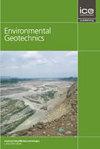Development of Innovative Plate Load Testing Equipment for In-Situ Saturated Clays Soils
IF 2.2
4区 工程技术
Q3 ENGINEERING, GEOLOGICAL
引用次数: 6
Abstract
This study proposes a method of gradually loading plate load on-site using lever arms to squeeze out pore water from clayey soils, allowing the soil to settle. Several types of tests were conducted, including a conventional field plate load test (CFPLT), a numerical field plate load test (NFPLT) and an innovative field plate load test (IFPLT) proposed in this study. Three trial pits with soils of varied engineering properties were studied using CFPLT, which employed the use of a heavy jack for load application, the NFPLT test using PLAXIS and an IFPLT, which employed a lever arm to magnify the applied static load. Disturbed soil samples collected from these trial pits were tested for index properties while the undisturbed soil samples were tested using the undrained triaxial compression test (UTCT) and laboratory consolidation tests. The results of the index properties classified these three clay soils as silt of low plasticity (ML) for clay from site 1, and clay of low plasticity (CL) for clay from site 2 and 3. The cohesion and angle of internal friction from the UTCT recorded cohesion values were 28, 29 and 37 kN/m2 for sites 1, 2 and 3, respectively, while the angle of internal friction values were 13, 8 and 6° for sites 1, 2 and 3, respectively. The plate load testing using the three methods showed similar graph pattern except that the allowable load occurred at approximately 350 kN/m2 for the CFPLT and 150 kN/m2 for the IFPLT. The high value of bearing capacity in CFPLT is due to the short period of time taken to load from a jack, which allowed the test to be completed within a short period of time. The ultimate bearing capacities computed from the laboratory test have values of 315.0, 231.0 and 270.0 kN/m2 for sites 1, 2 and 3, respectively. These values agree closely with the bearing capacities obtained for CFPLT but higher than the values recorded for the IFPLT. This is probably due to the long period of sustained loading during testing, which allowed for dissipation of pore water during each loading. Settlements obtained using the IFPLT were close to 25 mm, which is recommended as minimum settlements for building structures BS 8004, 1986.饱和粘土原位板载试验装置的研制
本研究提出了一种利用杠杆臂在现场逐步加载板荷载的方法,将粘土中的孔隙水挤出,使土壤沉降。进行了几种类型的试验,包括传统的现场板载试验(CFPLT),数值场板载试验(NFPLT)和本研究提出的创新场板载试验(IFPLT)。使用CFPLT(使用重型千斤顶进行载荷施加)、NFPLT(使用PLAXIS进行载荷施加)和IFPLT(使用杠杆臂放大施加的静载荷)对三个具有不同工程特性的试验坑进行了研究。从这些试验坑中收集的扰动土样品进行了指标特性测试,而未扰动土样品则使用不排水三轴压缩试验(UTCT)和实验室固结试验进行了测试。指标性质的结果将3种粘土土划分为低塑性粉土(ML)和低塑性粉土(CL)。UTCT记录的黏聚力和内摩擦角在1、2和3位点分别为28、29和37 kN/m2,而在1、2和3位点的内摩擦角分别为13、8和6°。使用这三种方法进行的板载测试显示出相似的图形模式,除了CFPLT的允许载荷大约为350 kN/m2, IFPLT的允许载荷大约为150 kN/m2。CFPLT中承载能力的高值是由于从千斤顶加载所需的时间短,这使得测试可以在短时间内完成。通过室内试验计算得出,站点1、站点2和站点3的极限承载力分别为315.0、231.0和270.0 kN/m2。这些值与CFPLT获得的承载能力非常接近,但高于IFPLT记录的值。这可能是由于在测试期间长时间的持续加载,这使得孔隙水在每次加载期间消散。使用IFPLT获得的沉降量接近25毫米,这是BS 8004, 1986建议的建筑结构最小沉降量。
本文章由计算机程序翻译,如有差异,请以英文原文为准。
求助全文
约1分钟内获得全文
求助全文
来源期刊

Environmental geotechnics
Environmental Science-Water Science and Technology
CiteScore
6.20
自引率
18.20%
发文量
53
期刊介绍:
In 21st century living, engineers and researchers need to deal with growing problems related to climate change, oil and water storage, handling, storage and disposal of toxic and hazardous wastes, remediation of contaminated sites, sustainable development and energy derived from the ground.
Environmental Geotechnics aims to disseminate knowledge and provides a fresh perspective regarding the basic concepts, theory, techniques and field applicability of innovative testing and analysis methodologies and engineering practices in geoenvironmental engineering.
The journal''s Editor in Chief is a Member of the Committee on Publication Ethics.
All relevant papers are carefully considered, vetted by a distinguished team of international experts and rapidly published. Full research papers, short communications and comprehensive review articles are published under the following broad subject categories:
geochemistry and geohydrology,
soil and rock physics, biological processes in soil, soil-atmosphere interaction,
electrical, electromagnetic and thermal characteristics of porous media,
waste management, utilization of wastes, multiphase science, landslide wasting,
soil and water conservation,
sensor development and applications,
the impact of climatic changes on geoenvironmental, geothermal/ground-source energy, carbon sequestration, oil and gas extraction techniques,
uncertainty, reliability and risk, monitoring and forensic geotechnics.
 求助内容:
求助内容: 应助结果提醒方式:
应助结果提醒方式:


